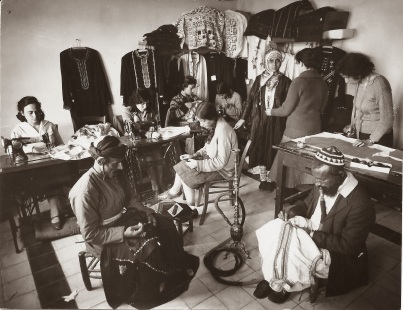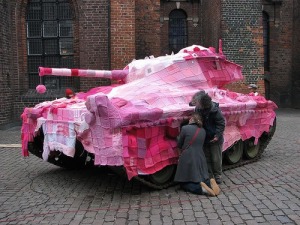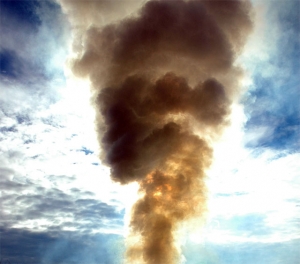Exodus 25:1 – 27:19
G-d Asks for the Work of the Artisan
This parsha is about beauty and closeness to G-d. It is displayed for us through the story and details surrounding the creation of the Mishkan – the Tabernacle – as well as the holy ritual objects of the sanctuary. Today our chumash reading explains the work and artistry that went into the creation of the first temple compound. So this week’s lesson is about the work of the artist as well.
This i s one of the most loved of the parashiot for the artists and the craftsman. This parsha lays out the details of the holy place and items that were to be constructed. We read not just of the holy tent, but also learn the details concerning the most sacred and precious items such as the Ark of the Covenant and Menorah. For this reason architects and artisans alike have often turned to this parsha for grand inspiration.
s one of the most loved of the parashiot for the artists and the craftsman. This parsha lays out the details of the holy place and items that were to be constructed. We read not just of the holy tent, but also learn the details concerning the most sacred and precious items such as the Ark of the Covenant and Menorah. For this reason architects and artisans alike have often turned to this parsha for grand inspiration.
So I come looking for something to speak to that creativity deep in me. And most surprisingly I find myself lingering here in our fifth reading.
At the top of our text it presents us with the instructions for certain items that needed to be woven for the mishkan. Among them are the parochet and the masach – the dividing partition and the screen-door to the inner-sanctuary.
This reading begins by detailing the first of these items that secure the tent sanctuary. It starts with the parochet – the cloth partition wall, the so-called “veil” of the tabernacle. We read:
|
“And you shall make a dividing curtain of blue, purple, crimson, and fine twisted linen – the work of a master weaver. And woven on to it shall be cherubim.” |
| Ve’asita parochet | techelet | ve’argaman | vetola’at | shani veshesh moshezar | ma’aseh choshev | ya’aseh otah keruvim. |
|
Exodus 26:31 |
|
Near the end of our reading we have an almost identical verse as it describes the masach. Here we also read:
|
“And you shall make a screen for the door of the tent of blue, purple, crimson, and fine twisted linen – the work of an embroiderer.” |
| Ve’asita masach | lefetach ha’ohel | techelet | ve’argaman | vetola’at | shani veshesh moshezar | ma’aseh rokem |
|
Exodus 26:36 |
|
These verses may not seem very deep, but they speak a lot to me. Of course for the scholar and the masters there are many deep and amazing things that can be brought down for these verses. About the colors spoken of (tichelet!), about the use of linen and the use of wool, or even the glory of G-d that they are supposed to be shrouded within. But today I’m not talking to scholars or tzadkim – I’m talking to the ben-oni, the common man like me, who face the everyday hardships and sorrows. I’ll tell you what I see.
When I look at this verse, even in my very common ways, I can’t help but be struck by the beauty of these verses. Me of all people, who is known for being rough. Yes, the punk exterior of me and my pals often comes off as boorish and untamed to some people. And then I sit and ask strangers to entertain the beauty of weaving and needlepoint, as with this text. That’s just my way.
They listen to me because of my sincerity as I ask them to practically consider crochet and doilies. With an attention to the delicacy that is so polar opposite to the role I’m supposed to play in their mind.
I can talk about it with passion because in this I see more than the facts and the Talmudic connections that slice through this text in my mind as I read. I get caught in the colors and the texture of it all.
And truth is, this text also touches me in a way that even I least expect. Not just because of the frilly and froufrou nature of these works. But also because these verses talk about division and separation. The protecting of the sacred space, by shrouding its inner sacredness from the outside. My rebel nature doesn’t like the idea of not being let in, I want to see it all and right now. That is how my anxious and curious nature normally works.
And so it is in the minds of many anxious and inspired readers as they read this parsha. We notice of all the wonders of the holy space and the sacred objects, and just when we get to the good parts, we then read about the partitions and screens that only the priests would be allowed to pass through.
Now notice these partitions are of wool threads and the screens of linen. The parochet is woven, the masach is likewise of cloth though it is embroidered. On the parochet we are told there were keruvim – cherambim, the forms mystical creations – woven into it.
What extra details can our tradition give us about this type of craft? The Talmud, and Rashi in-tern, describe this type of work more clearly when expounding upon verse 36. We are taught that the embroidery of the screen-door was blue, purple and deep-red like the parochet, but here Rashi also tells us that the needlepoint was done on the face and on the reverse as well. Both sides of the screen were covered with matching embroidery running through them, made of the richest threads they could produce. This wasn’t just a hollow-set or poster approach, it was adorned and decorated for appreciation outside and within, both front and back.
Yes, my restless mind wants to go inside, as there is something yet to be seen. So what stops a person here? Nothing more than the beauty of the threads and boldness of their colors. Even though one’s mind should tell them to rush forward in curiosity, the patterns catch my attention and mentally draw me back. You see the body and spirit wants to rush forward, but the soul stops it all at the patterned threads. And so in the face of these holy, royal and cautious colors I stop to consider the art instead.
Now there is a part of us all, which in the face of this type of example, wants to ask, “Why?” Why can’t I go inside to see what it looks like? Is it really the same? What are they hiding in there? We can’t help but ask why this is so, as the tabernacle veil is the archetypal example of spiritual barriers and limitations.
So what is this partition which drapes the sanctuary? We don’t really need a difficult explanation delivered to us. We know what is being protected. And when we consider it, the Holy of Hollies isn’t being protected from us. Quite to the contrary, we are being protected from the wonders within. From the amazing glory of Hashem. We are all aware of the safety measures taken for the priests, for when they are allowed to go there, and of their care in order to preserve their lives.
Yet our master Rashi, always in his tone as personal teacher, points this out again with care. He demystifies the masach as being a viylon – a curtain or a drape, not much more. Citing Job 1:10, Rashi tells us that this is like a hedge of protection; he uses his understanding of a mutual meaning as shared by the similar sounding, yet differently spelled, root words. By focusing on this thought, he asks us to consider the protection that G-d sets around those whom He blesses. This is what we understand as he says this, that by masach (screen-door) we are actually talking of lishon magen – a term for a protection, a shield.
These screens and partitions bore symbols of warning blazoned on them in brilliant threads. But not the “magen David” – the Shield of David, the “star of David.” No, instead they bore the symbols of the cherubim, the angelic creatures which guarded the inner chamber. This artistry was a warning to the outsiders of the danger and the glory within. Inside and out, they were woven and embroidered in this matching way to scream this in shocking colors.
However, as I look over the text I can’t help but entertain a thought. Could it be that there another reason still? Another reason to give a vision of this wonder on these partitions, one aside from warning people?
It appears to me that G-d did not just shut out the people from the Holy of Hollies without giving them a glimpse of the amazing and terrible realities within. On the very barrier instituted as a safety, on it G-d asked for the artisans to display a presentation for what was inside. These patters mirrored the golden standing cherubim within the Holy of Hollies and over the Ark of the Covenant.
For those who were not able to go inside and witness for themselves, it was displayed on the exterior. So that the average Israelite wouldn’t be left wondering and ever longing to see the deeper things.
In these so-called veils, we see the most exquisite craft works of the finest materials. Of the highest quality, and of the most delicate skill. But for as rich and precious as these works are, they are not really made for the benefit of G-d. They are made for us, for the benefit of the people. To protect us, and give us vision.
G-d doesn’t really need yarn crafts and needlepoint. It’s for people like you and me.
So when I see this barrier instead of wanting to mentally yank it down and march on in philosophically, I get stopped by the texture of the brilliant threads. The gentle artist in me demands I consider the layers of truth symbolized through these many loops and pulls woven into the pattern.
Now the artist in me also finds his eye lingering and his mind settling around another point. One which we first notice in the wording of verse 31, and that is then rightfully touched upon in the commentary for verse 36. Rashi’s commentary brings our attention to the final word of verse 36, and reads:
|
“An embroiderer: Heb. רֹקֵם, the name of the craftsman, not the name of the craft. Its Aramaic translation is עוֹבַד צַיָיר, work of an artist, but not עוֹבֵד צִיוּר, work of artistry.” |
רקם: שם האומן, ולא שם האומנות, ותרגומו עובד צייר. |
|
Rashi to Exodus 26:36 |
|
Our teacher points out to us here, that when Hashem gave this command to the people He did not ask them to make art works for Him. Nor did He asked them to make crafts. What He asked the Israelites to do is make “maaseh rokem,” – works of artisans, the works of craftsmen. It mentions rokem – craftsmen, though not the craft itself.
In this view G-d is actually more interested in the artists, more than the art itself. After all, it wasn’t really for Him anyway. Though this artistry and toiling was done for the honor of Hashem, it was primarily prescribed in order to give us security and inspiration. G-d calls people to do this work, creating these screens and adorning them. He wants the works of artisans and craftsman – but the crafts are just the product, though not the impetus.
Here in the most unlikely of lessons, one seeming as exciting to a grown man as talking about frills and lace, we end up getting a touching lesson on how to reach the hearts of the restless masses.
I wish more of us were like Rashi and able to understand art in a deeper away. But not just “art for arts sake”, but art for the sake of the artists. For the interest of the people. Art which displays both the wonders and dangers of spiritual exploration. Here we are challenged to use ones skills and gifts to take people mentally and spiritually beyond what the physical limitations normally allow. A closeness to the spiritual other-side that can’t be safely achieved by any other way. In vivid and stylized forms, G-d asks the artisan to give his art.
In this lesson the Torah reaches out to people like me who are tough, and often hard to reach by any other means aside from art. And likewise, Rashi as a wise teacher reaches out to the seeming “youth at risk” and gives us art to display our creativity through, as opposed to rushing to do damage.
So now I hand this over to you. Take a good look for yourself. What do you see in the pattern?
Art Project Possibility: After I posted this lesson I came across this project in the newsletter of my hometown synagogue, it’s a communal art projects called “Torah Stitch By Stitch” started by Canadian artist Temma Gentles.
 She explains the project this way, “Torah Stitch by Stitch is a project of ordinary people who want to experience the purpose, rigour and spirit of producing the holy texts. Rather than quill, ink and parchment, cross-stitch embroidery is used – a traditional method in many cultures for teaching young women to sew and to read.”
She explains the project this way, “Torah Stitch by Stitch is a project of ordinary people who want to experience the purpose, rigour and spirit of producing the holy texts. Rather than quill, ink and parchment, cross-stitch embroidery is used – a traditional method in many cultures for teaching young women to sew and to read.”
Their mission is described as follows: “It is possible – with 1463 volunteer stitchers plus fabricators and other helpers – that we will will produce the text of the Five Books of Moses. When these are assembled into 248 columns that comprise a Torah scroll, the artwork will occupy a space approximately 2 meters high by 86 meteres long. That would be a spectacular sight! And one tha tis sure to interest several prestigious museums.”
See their website to sign-up for the $18 registration starter-kit!
Related articles:

